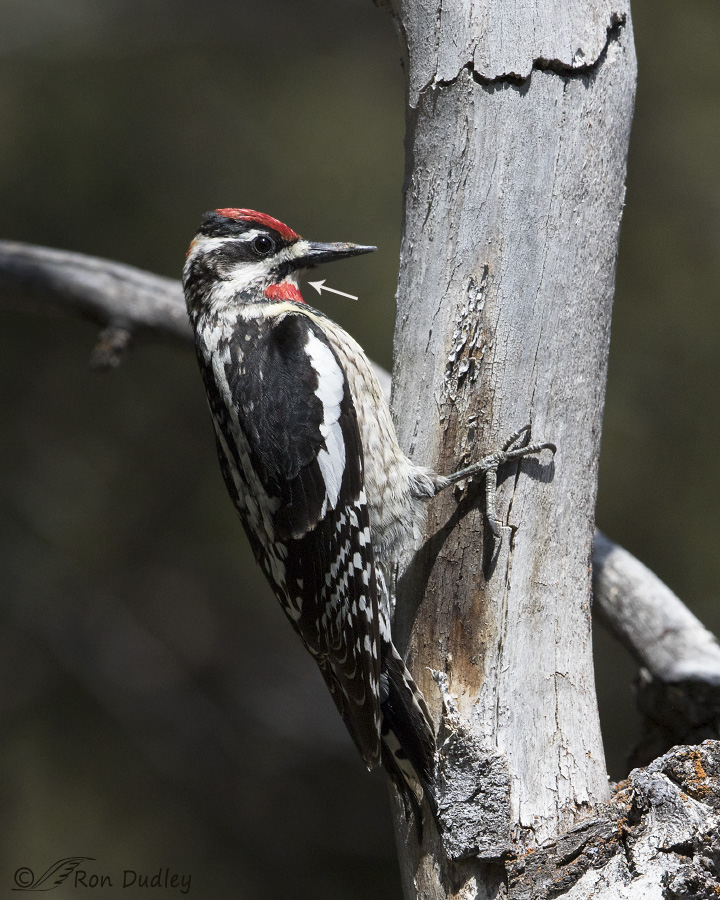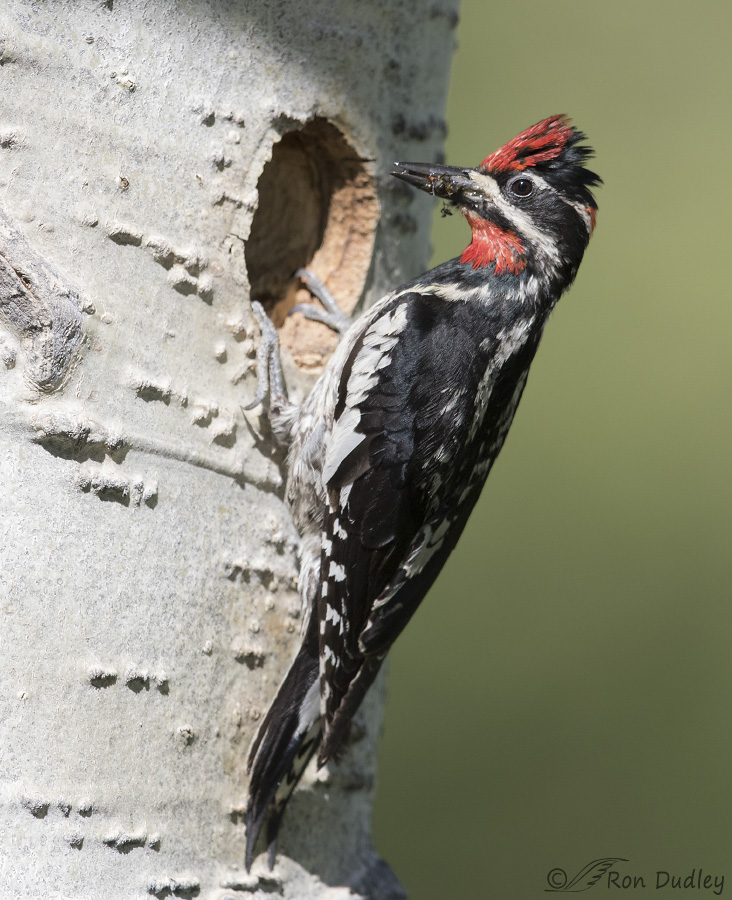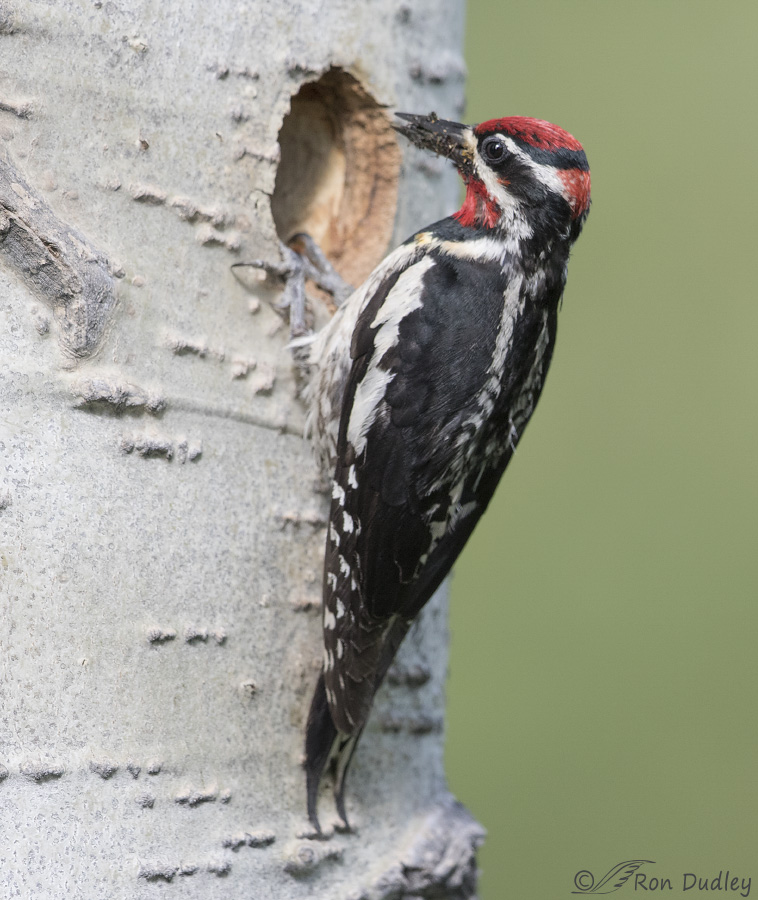Male and female Red-naped Sapsuckers are almost identical in plumage and size so sexing them in the field can be difficult.

1/2500/ f/7.1, ISO 500, Canon 7D Mark II, Canon EF 500mm f/4L IS II USM, not baited, set up or called in
The entire throat area of the male is solid red while the chin and upper throat of the female is typically white with red below. Because of the white chin I know this bird to be a female.
Usually the amount of red in the throat area can be used to accurately sex adults of the species but not always because the amount of red in the throat can be highly variable in some individual females.

1/3200/ f/6.3, ISO 640, Canon 7D Mark II, Canon EF 500mm f/4L IS II USM, not baited, set up or called in
Last week I photographed a nesting pair of Red-naped Sapsuckers that were very difficult to sex. In fact if I hadn’t been able to determine from their behaviors at the nesting tree that they were a mated pair at first glance I’d probably have thought they were both males because neither bird had any significant amount of white on the upper throat.
This is actually the female of the pair (I just happened to catch her with her crest raised).

1/1250/ f/4, ISO 800, Canon 7D Mark II, Canon EF 500mm f/4L IS II USM, not baited, set up or called in
And this is the male of the pair. Notice that neither bird has a predominantly white chin. So, since they’re so similar how do I know their sex?
In a pinch one more trait can be used to sex them. Notice that the female in the previous image has a distinct black border between the reds of her throat and the white stripe below her eye. In the male that black border is nonexistent or incomplete.
So, there are actually two traits that can be used to sex the species – the amount of red/white in the throat and chin and that black border between the red throat and the white stripe. In my experience there’s enough individual variation to make both traits useful in sexing the species.
I realize that this post will have limited interest for many of my readers – after all, Red-naped Sapsuckers aren’t even found in the eastern half of the US so many will never have seen them. But if you’re into birds minutia is often significant and this is where my mind went for today’s post.
Ron


Just now getting to this one. Yesterday was BUSY!
I LOVE the detail and crispness of these photos–just LOVE it! There’s not a chance I’ll remember those details by the time I get moved and actually get out on the western landscape again. I will have slept since then and sometimes soundly. Stuff falls out!
Personally, I love the minutia of life. It’s a joy to contemplate and ponder those things. And while we often struggle with identifying gender, the birds know it immediately, just like we recognize our differences.
Let me also repeat just how grateful I am for your blog every day. Seriously GRATEFUL! Thank you!
PS: Some birds make it very difficult don’t they. For us, anyway…
“For us, anyway…”
Yup. Birds themselves don’t seem to have much of a problem with it.
My ever loving family tells me ‘small things for small minds’. Sadly (or not) I love the minutae. And if ever I see a sapsucker while I am out walking I will know what to look for…
And, knowing I will never see them, I am still grateful for the information and the series. As for the markers being indistinct, that falls into the ‘messing with your mind’ category at which birds excel.
EC, “indistinct markers” are a somewhat common occurrence with birds so I think the practice does us all good, even with birds we’re unfamiliar with. And as you say, dealing with them isn’t easy…
Dear Ron—I am probably just being picky but I am having trouble seeing a black strip between the white and red of the first female’s image—perhaps if you have the one marker you do not necessarily need the other?
You’re right, Bobbi. That black border is indistinct in that bird (at least in this photo) but I believe it’s there. It’s one of the reasons I suggest using both field marks in making sex determination.
Nice, crisp images and interesting information…I would never have noticed such a fine distinction. Mia isn’t the only “Eagle eyes”!!!
Believe me, Patty, these details aren’t things I’d have likely spotted in the field while I was photographing the birds. Mia often does though.
Beauty and knowledge are in the details…one of the reasons I love browsing field guides, so thanks!
Susan, I’ve never been one to spend much time browsing field guides unless I’m looking for something specific. But when it comes to my own images it’s a completely different story.
Thank you for a very helpful lesson. I had one serious encounter with a Red-naped Sapsucker at Hueco Tanks a couple of years ago – with a bird who seemed to enjoy posing for me. I found one of my photos, looked at it closely, and discovered that the bird was a female, thanks to the black strip on her face. She had essentially no white on the throat. We see them in winter, and as with all Woodpecker-type birds, they are a lot of fun to be around.
Thanks. If I ever get the chance to see one of these up close and personal…..well, hopefully I can remember!!! Beautiful birds.
Hopefully I can remember too, Carol. Sometimes it’s so long between sightings of a species that I forget some of that stuff.
You should be called Hawkeye!
Great shots, excellent lesson, and much appreciated!
Photographs are a heck of a lot better then the old way of collecting information about ID characters!!
Thanks for sharing!
Ha, If I were Hawkeye then Mia would have to be Hotlips. Don’t think she’d like that…
VBG!!
Thank you for the lessons. First about Red-naped Sapsuckers. More importantly, a very nice lesson in how to go about it when identifying birds and sexes in the field. Learn the right marks, look closely. It does not matter that your subject is not found in the east; the lessons apply. Finally, isn’t it great to be able to use a photo to ID a bird after the fact?
“isn’t it great to be able to use a photo to ID a bird after the fact?
Absolutely, Richard! When I’m photographing birds I usually have to concentrate on the process of photography rather than the details of ID so it’s wonderful to be able to check the photos later at my leisure.
Great tutorial, Ron as well as great photo’s of the birds! Don’t believe I’ve ever seen one – they are similar to the Hairy Woodpeckers we get here.
Don’t believe I’ve ever seen one – they are similar to the Hairy Woodpeckers we get here.
Thank you, Judy.
Great lesson Ron. Now if I can just remember what you’ve taught us, so that if I’m ever lucky enough
to see a Red-naped Sapsucker here in Sarasota, Florida, I’ll be able to tell if I’m looking at a male, or
a female… however, since the are not even found this far to the east, I’m out of luck. Except I’ll be
driving west to Washington state in September… I’ll keep my eyes open, and dazzle my wife with my
ability to not only identify the bird, if we see one, but also to determine the sex. I’m sure she will be
so impressed… As you can see from my ramblings, I didn’t get enough sleep last night. But, what I
do know is that I thoroughly enjoy your Biology lessons, and am totally amazed by your photography
skills. ;-)))
I hope you get to see some of these sapsuckers on your trip out west, Roger
What sensational shots and interesting identification information!
Charlotte
Thanks, Charlotte.